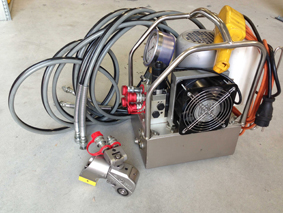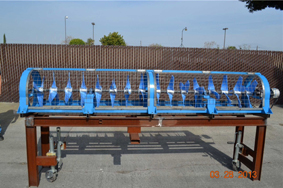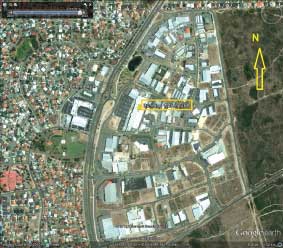- Category: Articles
 Smart Bolting Tools for the Wind Power Industry
Smart Bolting Tools for the Wind Power Industry
In today’s multi-megawatt wind towers, various types of bolting equipment are used to tighten the thousand or more bolted connections in each wind tower. The time when most of these bolts need to be tightened is during the site installation, and the bolting equipment used requires generators and lifting equipment in order to be operated.
By Marcel Birkhoff, General Manager, RAD Torque Systems BV, The Netherlands
- Category: Articles
 How Probabilistic Wind Power Prediction can Help in Optimising Operations
How Probabilistic Wind Power Prediction can Help in Optimising Operations
It is now widely accepted that wind power forecasts can help utilities and transmission system operators (TSOs) integrate highly variable wind power into their operations. These forecasts are known as ‘deterministic’ predictions and are often based on numerical weather prediction model wind forecasts, which are then optimised and converted to deterministic power forecasts. Now, additionally, forecast providers are beginning to provide ‘probabilistic’ forecasts that can quantify the uncertainty of the prediction. These probabilistic forecasts are traditionally produced by running the models with slightly different scenarios, producing an ensemble of possible predictions. Newer methods are providing ways to accurately quantify the uncertainty with fewer ensemble members or even by creating an ensemble from a single deterministic run – an analog ensemble. Such methods to quantify the uncertainty are making it possible to further optimise wind power integration.
By Dr Sue Ellen Haupt and Dr Luca Delle Monache, National Center for Atmospheric Research, USA
- Category: Articles
The Use of Train-Generated Mass Airflow to Produce Electricity
 When wind power is mentioned, most of us think of the ‘classic’ tower plus blades design of above-ground onshore or offshore wind turbine generators. But, as this article about using the airflow generated by underground trains illustrates, there is potential to adapt wind turbine generator designs to harness ‘wind’ energy from other sources.
When wind power is mentioned, most of us think of the ‘classic’ tower plus blades design of above-ground onshore or offshore wind turbine generators. But, as this article about using the airflow generated by underground trains illustrates, there is potential to adapt wind turbine generator designs to harness ‘wind’ energy from other sources.
By Norman H. Holley, COO, WWT Tunnel, USA
- Category: Articles
A New High Capacity Rotor

Most wind turbines focus on maximising the efficiency with which power is extracted from the wind. By contrast, the focus at Lux Wind Power is on creating a wind turbine rotor that has a larger swept area in order to extract power at the lowest achievable cost. The large swept area rotor is expected to generate electricity at a much lower levelised cost of energy (LCOE) when compared to existing wind turbine technologies and Lux Wind Power is currently seeking financial support from the industry, investors and/or partners to bring this much-needed product to market.
By Glen Lux, CTO/Manager and Founder, Lux Wind Power, Canada
- Category: Articles
A Strategic Approach to Risk-Based Wind Development
 Investing in a wind farm is an expensive business and can seem to be too risky for more cautious fund holders. Investors are more likely to be interested if it is possible for them to make a better informed decision on the projected financial returns. In particular, the estimate of how much energy the farm is likely to produce is critical to the final funding decision. The well-understood problem here is that energy production can only ever be an estimate during the planning phase, but how certain is that estimate? A new model makes it possible to be much more precise about the level of uncertainty and this should allow potential partners to define, and act on, the comfort zone within which they are prepared to work.
Investing in a wind farm is an expensive business and can seem to be too risky for more cautious fund holders. Investors are more likely to be interested if it is possible for them to make a better informed decision on the projected financial returns. In particular, the estimate of how much energy the farm is likely to produce is critical to the final funding decision. The well-understood problem here is that energy production can only ever be an estimate during the planning phase, but how certain is that estimate? A new model makes it possible to be much more precise about the level of uncertainty and this should allow potential partners to define, and act on, the comfort zone within which they are prepared to work.
By Matthew Hendrickson, Vice President of Energy Assessment, and Francesca Davidson, Marketing Manager, Vaisala Inc. (formerly 3TIER), USA
- Category: Articles
 Energy storage systems (ESSs) will be critical to the provision of an affordable, sustainable and secure electricity supply. ESSs support an increase in electricity consumed nearer to generation sources, bringing much needed cost efficiencies. They also make grids more flexible, reliable, resilient and stable. For example, when the frequency drops from its nominal value (which could cause parts of the network to shut down), frequency regulation enables energy companies to quickly ‘inject’ just the right amount of additional, controllable power into the grid. But what are the key challenges that need to be overcome from a technology, standards, market regulation and business model perspective?
Energy storage systems (ESSs) will be critical to the provision of an affordable, sustainable and secure electricity supply. ESSs support an increase in electricity consumed nearer to generation sources, bringing much needed cost efficiencies. They also make grids more flexible, reliable, resilient and stable. For example, when the frequency drops from its nominal value (which could cause parts of the network to shut down), frequency regulation enables energy companies to quickly ‘inject’ just the right amount of additional, controllable power into the grid. But what are the key challenges that need to be overcome from a technology, standards, market regulation and business model perspective?- Category: Articles
 The method discussed in this article shows a low-cost approach to gain an insight into the wind conditions for a small wind turbine in the highly turbulent setting of the rooftop of a large building. Such an insight provides wind resource assessment and also guidance in micro-siting wind turbines.
The method discussed in this article shows a low-cost approach to gain an insight into the wind conditions for a small wind turbine in the highly turbulent setting of the rooftop of a large building. Such an insight provides wind resource assessment and also guidance in micro-siting wind turbines.









